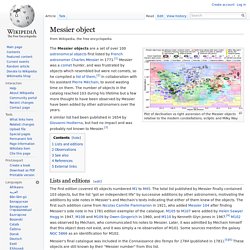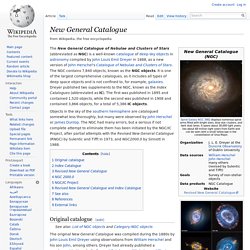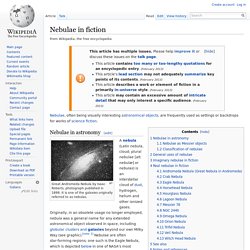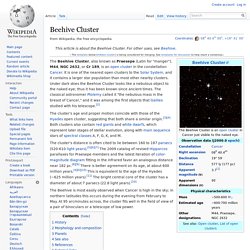

Deciphering History Together. O'Neill cylinder. Artist's depiction of a pair of O'Neill cylinders The O'Neill cylinder (also called an O'Neill colony) is a space settlement design proposed by American physicist Gerard K.

O'Neill in his 1976 book The High Frontier: Human Colonies in Space.[1] O'Neill proposed the colonization of space for the 21st century, using materials extracted from the Moon and later from asteroids.[2] Interior view, showing alternating land and window stripes Background[edit] While teaching undergraduate physics at Princeton University, O'Neill set his students the task of designing large structures in outer space, with the intent of showing that living in space could be desirable.
O'Neill's project was not completely without precedent. Islands One, Two and Three[edit] O'Neill created three reference designs, nicknamed "islands": Island One[edit] Island Two[edit] The Scale of the Universe 2.
Messier object. Plot of declination vs right ascension of the Messier objects relative to the modern constellations, ecliptic and Milky Way The Messier objects are a set of over 100 astronomical objects first listed by French astronomer Charles Messier in 1771.[1] Messier was a comet hunter, and was frustrated by objects which resembled but were not comets, so he compiled a list of them,[2] in collaboration with his assistant Pierre Méchain, to avoid wasting time on them.

The number of objects in the catalog reached 103 during his lifetime but a few more thought to have been observed by Messier have been added by other astronomers over the years. A similar list had been published in 1654 by Giovanni Hodierna, but had no impact and was probably not known to Messier.[3] Lists and editions[edit] The first edition covered 45 objects numbered M1 to M45. Messier lived and did his astronomical work at the Hôtel de Cluny (now the Musée national du Moyen Âge), in France. Observations[edit] New General Catalogue. The New General Catalogue of Nebulae and Clusters of Stars (abbreviated as NGC) is a well-known catalogue of deep-sky objects in astronomy compiled by John Louis Emil Dreyer in 1888, as a new version of John Herschel's Catalogue of Nebulae and Clusters of Stars.

The NGC contains 7,840 objects, known as the NGC objects. It is one of the largest comprehensive catalogues, as it includes all types of deep space objects and is not confined to, for example, galaxies. Dreyer published two supplements to the NGC, known as the Index Catalogues (abbreviated as IC). List of open clusters. Caldwell catalogue. Herschel 400 Catalogue. The Herschel 400 catalogue is a subset of William Herschel's original Catalogue of Nebulae and Clusters of Stars, selected by Brenda F.

Guzman (Branchett), Lydel Guzman, Paul Jones, James Morrison, Peggy Taylor and Sara Saey of the Ancient City Astronomy Club in St. Augustine, Florida, USA c. 1980. They decided to generate the list after reading a letter[1] published in Sky & Telescope by James Mullaney of Pittsburgh, Pennsylvania, USA.[2] In this letter Mr. Mullaney suggested that William Herschel's original catalogue of 2,500 objects would be an excellent basis for deep sky object selection for amateur astronomers looking for a challenge after completing the Messier Catalogue. List of Messier objects. Nebulae in fiction.
Nebulae, often being visually interesting astronomical objects, are frequently used as settings or backdrops for works of science fiction.

Nebulae in astronomy[edit] Great Andromeda Nebula by Isaac Roberts, photograph published in 1899. It is one of the galaxies originally referred to as nebulas. A nebula (Latin nebula, cloud; plural nebulae [alt. nebulæ] or nebulas) is an interstellar cloud of dust, hydrogen, helium and other ionized gases. Originally, in an obsolete usage no longer employed, nebula was a general name for any extended astronomical object observed in space, including globular clusters and galaxies beyond our own Milky Way (see graphic).
M44-LRGBv1.jpg (JPEG Image, 1000 × 1000 pixels) Beehive Cluster. This article is about the Beehive Cluster.

For other uses, see Beehive. The cluster's distance is often cited to lie between 160 to 187 parsecs (520-610 light years).[5][6][7] The 2009 catalog of revised Hipparcos parallaxes for Praesepe members and the latest iteration of color-magnitude diagram fitting in the infrared favor an analogous distance near 182 pc.[8][9] There is better agreement on its age, at about 600 million years.[4][6][10] This is equivalent to the age of the Hyades (~625 million years).[11] The bright central core of the cluster has a diameter of about 7 parsecs (22.8 light years).[10] The Beehive is most easily observed when Cancer is high in the sky; in northern latitudes this occurs during the evening from February to May. How to make a rocket with sugar and kitty litter. Got some powdered sugar and kitty litter just lying around?

Sure, there are some more practical uses for both of those things, but let's add some potassium nitrate to the mix and blow it all sky-high. [optional caption text here] Image: [name here]/Shutterstock. Comet Siding Spring whizzes past Mars. A comet the size of a small mountain has whizzed past Mars, dazzling space enthusiasts with the once-in-a-million-years encounter.

The comet, known as Siding Spring (C/2013 A1), made its closest encounter with Mars on Sunday at 2.27pm on Sunday (0527 AEDT Monday), racing past the Red Planet at a breakneck 203,000km/h. At its closest, Siding Spring was 139,500km from Mars - less than half the distance between Earth and our moon. "Signal confirming closest approach has just been received," the European Space Agency said on Twitter. Comet Siding Spring makes close fly-by of Mars in rare encounter. Updated A comet the size of a small mountain has whizzed past Mars, wowing space enthusiasts with the once-in-a-million-years encounter.

The comet, known as Siding Spring, passed just 140,000 kilometres from Mars, less than half the distance between Earth and the Moon and 10 times closer than any known comet has passed by Earth, NASA said. The comet made its closest approach to Mars at 5:27am (AEDT), hurling past at about 203,000 kilometres per hour. NASA's fleet of Mars-orbiting satellites and robots on the planet's surface were primed for the fly-by of the comet, hoping to photograph the rare event. Mountain-Sized Comet Siding Spring Whizzes Past Mars.
Washington: A comet the size of a small mountain whizzed past Mars on Sunday, dazzling space enthusiasts with the once-in-a-million-years encounter.

The comet, known as Siding Spring (C/2013 A1), made its closest encounter with Mars on Sunday at 2:27 pm (1827 GMT), racing past the Red Planet at a breakneck 126,000 miles (203,000 kilometers) per hour. At its closest, Siding Spring was 87,000 miles (139,500 kilometers) from Mars -- about a third the distance between Earth and our moon. Before the comet passed, it could be seen in space racing toward the brightly illuminated Red Planet, trailed by a cloud of debris. Scientists said the comet's passing offered a unique chance to study its impact on Mars's atmosphere. "What could be more exciting than to have a whopper of an external influence like a comet, just so we can see how atmospheres do respond? " Comet Siding Spring Soars Past Mars. Bbc.com A recently discovered comet has whizzed past Mars, giving scientists a unique chance to study an object from the farthest reaches of the Solar System.
The comet, known as Siding Spring, raced past Mars at 56km per second (125,000mph), missing it by 139,500 km. Rovers on the Martian surface and satellites were primed to catch the event on their cameras and instruments. CMB wrinkles. Sixty Symbols. Big Bang Theory.
Lunaria. Here's How You Can Help Scientists Study Sex, Whales, and Distant Galaxies. "There is so much we don't know! " said Dick Vane-Wright, the Keeper of Entomology at the London Museum of Natural History when author Sharman Apt Russell was asking about butterflies. "You could spend a week studying some obscure insect and you would then know more than anyone else on the planet. Our ignorance is profound. " Cosmos, Moby’s Song ‘We Are All Made of Stars’, Universe & Solar System. The theory that everyone and everything on Earth contains minuscule star particles dates back further than Moby's popular 2002 song "We Are All Made of Stars.
" In the early 1980s, astronomer Carl Sagan hosted and narrated a 13-part television series called "Cosmos" that aired on PBS. On the show, Sagan thoroughly explained many science-related topics, including Earth's history, evolution, the origin of life and the solar system. "We are a way for the universe to know itself. Some part of our being knows this is where we came from. We long to return. His statement sums up the fact that the carbon, nitrogen and oxygen atoms in our bodies, as well as atoms of all other heavy elements, were created in previous generations of stars over 4.5 billion years ago. "All organic matter containing carbon was produced originally in stars," Impey told Life's Little Mysteries.
Quantum Mechanics.